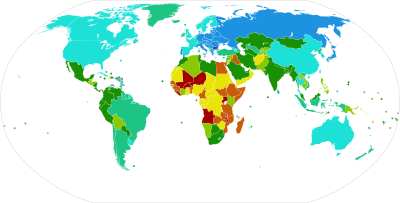
| ≥ 30 25 – 29.99 20 – 24.99 15 – 19.99 | 10 – 14.99 5 – 9.99 0 – 4.99 -5 – -0.01 | < -5 Data unavailable |
In demography and population dynamics, the rate of natural increase (RNI), also known as natural population change, is defined as the birth rate minus the death rate of a particular population, over a particular time period.[1] It is typically expressed either as a number per 1,000 individuals in the population[2] or as a percentage.[3] RNI can be either positive or negative. It contrasts to total population change by ignoring net migration.
This RNI gives demographers an insight into how a region's population is evolving, and these analyses can inform government attempts to shape RNI.
- ^ Rogers, Luke; Borsella, Peter (March 24, 2016). "Growth or Decline: Understanding How Populations Change". United States Census Bureau.
- ^ "World Population Prospects". United Nations Department of Economic and Social Affairs.
- ^ "Estimates, 1950 - 2020: Annually interpolated demographic indicators - Rate of natural increase (per 1,000 population)". Our World In Data.